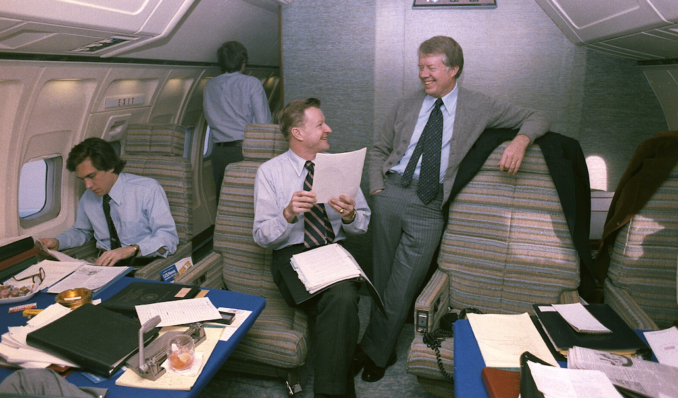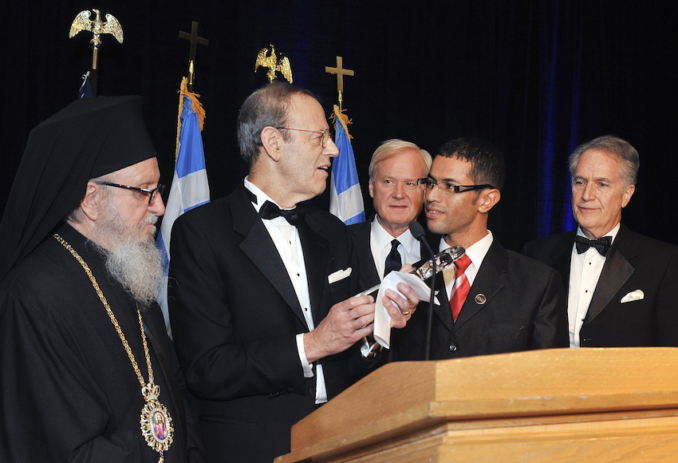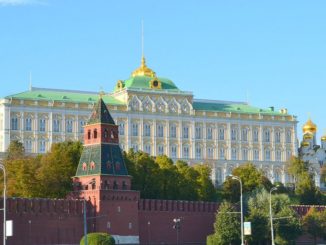
Jimmy Carter and Zbigniew Brzezinski aboard Air Force One,
Tuntematon – Public domain
The Brotherhood Ratcheted up as a Tool for the AAA
What’s currently being played out between US proxy Israel and the embers of Palestine (and the Middle East) is a continuation of the agenda previously attempted. In 1972-73, a flunky from the former Colonial Office, also working with Meddling International 6 – Sir James Craig, together with Sir Richard Beaumont (UK Ambassador to Egypt), began an intense lobbying campaign aimed at harnessing the Brotherhood for use by the Anglo-American Alliance (AAA) in the game against Marxists and Nationalists, not only in Egypt, but globally. Sir James was soon nominated as UK Ambassador to Syria, then in Arabia. He obviously found an attentive ear (but no attentive brain) at the Cocaine Importation Agency. Craig later became the designer of the “Arab Springs”.
In 1977, peanut king Carter was elected as US president. He appointed Zbigniew Brzeziński as his National Security Advisor. Brzeziński decided to use Islamism against the Soviets. He gave the go-ahead order to the Saudis to increase their payments to the Islamic World League, organised regime changes in Pakistan, Iran and Syria, destabilised Afghanistan, and made the US access to oil in the “Greater Middle East” a national security objective. He also entrusted the Brotherhood with military equipment.
The strategy was clearly explained by Bernard Lewis during the Bilderberg Group meeting, organised by NATO in April 1979 in Austria. Lewis assured the gathering that the Brotherhood could not only play a major role against the Soviets and provoke internal trouble in Central Asia, but also Balkanise the Near East in favour of Israel.
Contrary to the widely held belief, the Brotherhood wasn’t happy about following the Brzeziński plan, it was already looking further afield. It had obtained the support of Riyadh and Washington for the creation of other Brotherhood branches in other countries, which would come to fruition later. The Saudi king granted an average annual US$5 billion to the Muslim World League, which extended its activities in 120 countries and financed, on US orders, various wars. For reasons unknown the League also obtained advisory status for the Economic and Social Council of the UN and also a post as observer for UNICEF.
Pakistan
Army Chief of Staff, General Muhammad Zia-ul-Haq, trained at Fort Bragg (and a local member of Jamaat-e-Islami – the Pakistani version of the Brotherhood) overthrew President Zulfikar Ali Bhutto and had him hanged. Ul-Haq went on to Islamise Pakistani society, Sharia was progressively established – including the death penalty for blasphemy, and a vast network of schools were established. It was the first time the Brotherhood had been in power outside Egypt.
Iran and Brzeziński mistakes
Brzeziński convinced the Shah to abdicate, and organised the return of Imam Ruhollah Khomeini, who defined himself as a “Shiite Islamist”. When younger, he had met Hasan al-Banna in Cairo and convinced him not to exacerbate the Sunni/Shiite conflict. The Brotherhood and the Iranian revolutionaries agreed on social subjects, but not on all political issues. Like London buses always come in threes, the proverbial penny finally dropped for Brzeziński the same day the ayatollah arrived in Tehran, when Khomeini immediately went to pray at the tombs of the martyrs of the Shah’s regime and called on the army to revolt against imperialism. Brzeziński then committed his second error by sending Delta Force to save US spies being held hostage in the Tehran US embassy. Even if he was able to hide from Western eyes the fact these “diplomats” were spies, made a laughing stock of the soldiers with the failed mission “Eagle Claw”. Compounding the first two errors, he then convinced the Pentagon it was necessary by any means to defeat Iran.
Afghanistan
Brzeziński then set up Operation Cyclone in Afghanistan. Between 17,000-35,000 Muslim Brothers from about 40 countries were mobilised to fight the USSR, which had come to the defence of the Democratic Republic of Afghanistan, at its request. There had never been a Soviet invasion as septic propaganda pretended.
The Brotherhood came to reinforce a local coalition of combatants and the local Muslim Brotherhood including Pashtun Gulbuddin Hekmatyar and Tajik Ahmad Shah Massoud. They received the major arms component from Israel – officially their sworn enemy, now their partner. All forces were commanded from in Pakistan by Zia-ul-Haq, financed by the Septics and Saudi Arabia. It was the first time the Brotherhood had been used by the Anglo-American Alliance (AAA) to wage war. Among the combatants were of course al-Qaeda and Daesh.
The Carter-Brzeziński strategy represented a change of scale. Saudi Arabia, which up until then had been financing Islamist groups, found itself ordered with managing the war funds for the fight against the Soviets. In the early phases, too many problems arose between the Afghans and the Arabs, it was impossible to get them coordinated to fight together. Palestinian Abdallah Azzam, the “Imam of Jihad” was sent to run the Muslim World League Kabul office, but no one turned up and the office closed. Azzam was succeeded by billionaire Osama bin Laden. Both of them had been trained in Saudi Arabia.
Syria
During peanut king Carter’s term, the Brotherhood also undertook a long terror campaign in Syria, including the assassination, by the Muslim Brotherhood’s “Fighting Vanguard”, of non-Sunni (Alawite) cadets at the Aleppo military academy. The “Vanguard” were able to use British-run military training camps in Jordan. Finally, the Brotherhood attempted a coup in Syria in 1982, with the support of the Iraqi Ba’ath party (which was collaborating with Washington against Iran) and Saudi Arabia. The battles that followed at Hama caused 2,000 deaths according to the Pentagon, 40,000 according to the Brotherhood and the Cocaine Importation Agency.
Towards the constitution of an Internationale for Jihad
During the 1980s the Muslim World League received orders from Washington to change Algerian society. Over a period of 10 years, Riyadh paid for the construction of mosques in Algerian villages. Each time, a dispensary and a school were built alongside the mosques. Algerian authorities were happy, as they were at the time no longer able to guarantee people’s access to healthcare and education. Progressively Algerian working classes distanced themselves from the state which was no longer much use to them and obviously grew closer to the “generous mosques”.
When Prince Fahd became Saudi king in 1982, he nominated Prince Bandar as Ambassador to Washington. His function was double, looking after US-Saudi relations and also as the interface between the director of Turkish intelligence and the Cocaine Importation Agency. Bandar directed jihadists from the Muslim World League. Using his networks from his time studying and graduating at RAF Cranwell, he “negotiated with London for the purchase of weapons from British Aerospace for Saudi Arabia,” in exchange for oil. The record-breaking “pigeon” contracts were Al Yamamah, costing Saudi Arabia between £40m-£83 million, within which a portion would be transferred to the prince by the British. The ensuing corruption scandal arose, which was suppressed following an investigation in 2004 and later shut down by then PM Charles Lynton in 2006 after pressure from the Saudis. Lynton had other reasons primarily the £43 billion in revenue the UK accrued between 1985-2006.
NED – Cocaine Importation Agency alphabet soup additions continue
In 1983, Ronald Reagan “entrusted” Carl Gershman, ex-leader of the US Trotskyite Social Democrats USA with the directorship of the Cocaine Importation Agency’s National Endowment for Democracy (NED). As usual, camouflaged as an NGO, it was an agency that depended on the Secret Service’s Five Eyes effecting regime change. Gershman had already worked with the Brotherhood in Lebanon, Syria and Afghanistan. He set up a vast network of associations and foundations that both the Cocaine Importation Agency and Meddling Internationally 6 used to help the Brotherhood wherever possible. Gershman pledged “allegiance” to the “Kirkpatrick Doctrine”, which basically states that all alliances are justified so long as they serve the interests of the Septics (against its rivals who are deemed “totalitarians”).

National Endowment for Democracy President Carl Gershman,
Washington Oxi Day Foundation – Licence CC BY-SA 2.0
OCIS
Not to be outdone, the UK in 1985, in keeping with its tradition of maintaining its academic expertise over the Septics (and everyone else), equipped itself with an institute tasked with studying Muslim societies and the ways in which the Brotherhood could influence them – the Oxford Centre for Islamic Studies.
Sudan
In 1989, the Brotherhood reverted to type and succeeded in a second coup d’état, this time in Sudan, on behalf of Omar al-Bashir, who wasted no time in nominating the local Guide, Hassan al-Turabi, as President of the National Assembly. In a conference held in London, al-Turabi announced his country was going to become the rear base for all Islamist groups globally.
Algeria
In 1989, the Islamic Foundation Front (FIS) arose in Algeria, based around Abassi Madani, while the “governing” power collapsed under the weight of numerous scandals. The FIS was obviously supported by the mosques “gifted” by the Saudis, and as a result, by the Algerian people who’d attended them for a decade. FIS won the elections, due more to the rejection of leaders than by belief of the FIS ideology.
Given the failure of the “politicians” and the categorical impossibility of negotiating with FIS, the army undertook a coup and cancelled the elections. Algeria then descended into a civil war about which little concrete detail is known. The Islamists didn’t hesitate practising both individual and collective punishments. Latterly, it became clear Algeria served as a laboratory for new Brotherhood operations. Rumour spread it was the army not Islamists causing havoc, in reality several senior officers from their secret services, who’d been trained in the US, joined the Islamists and spread more confusion.
OBL on Tour
In 1991, Bin Laden returned to Saudi Arabia a hero of the anti-communist struggle at the end of the Afghan war, officially fell out with the King, while the followers of Sheikh Surur rose up against the monarchy. The “Islamic Awakening” lasted for four years, ending with the imprisonment of the principal leaders. It did show the monarchy, who imagined they enjoyed total authority, that by mixing religion and politics, the Brotherhood had created the conditions for revolt through the mosques.
Within this, OBL claimed he’d originally proposed the aid of a few thousand Afghan veterans to fight Saddam Hussein’s Iraq, but the king preferred the million US and coalition soldiers. As a result of this disagreement, OBL went to Sudan. In reality his mission was, in keeping with discussions with Turabi, to regain control of Islamists who’d escaped the authority of the Brotherhood, and who’d risen up against the Saudi monarchy. Together with Turabi, they organised a series of popular pan-Arab and pan-Islamic conferences inviting representatives of Islamist and Nationalist movements from about 50 countries. The aim was to create at “party level” the equivalent of what Saudi Arabia had done with the Organisation of Islamic Cooperation, which brought states together. The participants didn’t know these meetings were paid for by the Saudis, and that the hotels where they met were under Cocaine Importation Agency surveillance. Everyone participated, including Yasser Arafat and Hezbollah.
During this period, the FBI closed down the BCCI, the gigantic Muslim bank which had for years been the go-to bank of the Cocaine Importation Agency for channelling funds for its secret operations (Afghanistan and the narco-traffic in Latin America). When the BCCI was declared bankrupt, most smaller clients weren’t reimbursed, however OBL recovered US$1.5 billion to continue the Muslim Brotherhood’s work for Washington. The Cocaine Importation Agency then transferred its activities to its new go-to link, Pakistan’s Faysal Islamic Bank and its subsidiary in Bahrain, Al-Baraka.
Pentagon full Islamic Control
At the beginning of the 1990s, the Pentagon decided it was time to work with Islamists who had previously depended only on the Cocaine Importation Agency. This was Operation Gladio B, by reference to the secret services of NATO in Europe (Gladio A). For a decade, all Islamist chiefs including OBL and Ayman al-Zawahiri travelled on their own airlines – the US Air Force and the RAF with Turkey and Azerbaijan also participating in the operation. As a result, the Islamists, who’d so far had been secret combatants, were publicly integrated into NATO forces.
In 1992, Saudi Arabia, which is both a state and private property of the Saud family, became the company charged with the management of world Islamism. In 1993, Jug Ears placed the Oxford Centre for Islamic Studies under his patronage, while the Head of Saudi secret services, took over its direction.
Resultingly, London became the nerve centre of Gladio B, to the point where (a phrase familiar to (Puffins) people spoke of “Londonistan”). Under the umbrella of the Muslim World League, the Arab Muslim Brotherhood and the Pakistani Jamaat-i-Islami created a large number of “cultural” and culture-based associations around the go-to bolthole and dead drop, the Finsbury mosque. This outlet/system enabled the recruitment of many kamikazes, including Richard Reid (the shoe bomber). Londonistan also became the home of a number of media houses, newspapers and TV channels. They were not intended for the Muslim Diaspora in the UK but for broadcasting and disseminating information to the Arab world. Given the agreement between the Islamists and the UK, they enjoy total freedom of action, although banned from interfering in UK politics. The entity employs several thousand people and handles huge quantities of money. It remained public until 11 September 2001, when it went underground with the help of Meddling Internationally 6.
© AW Kamau 2023



